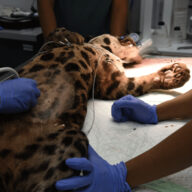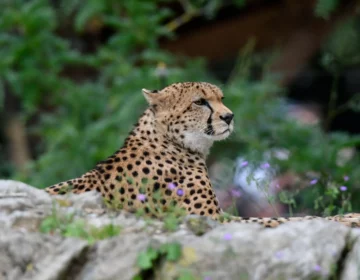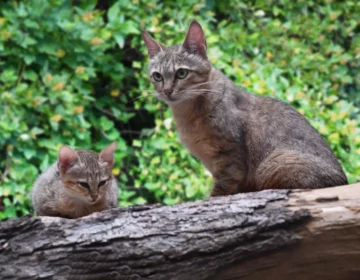
Leopard
Panthera pardus
Leopard
APPEARANCE
Leopards vary greatly in size and colouration throughout their wide geographical range.
Leopards in Africa are usually the largest and can weigh up to 90 kg. Typically, leopard fur is yellowish to olive and black-spotted with unique patterns. Melanistic individuals are rare in Africa, but in humid forest habitats, as in Java and Malaysia, melanism is more common. The colour and patterns of leopard fur appear to be related to habitat type. Leopards inhabiting the savannah are fawn to ochre in colour, leopards in deserts are lighter to yellowish brown, and in colder regions are more greyish. Rainforest individuals are darker and golden in colour, while leopards living in high mountains are even darker than those in the rainforest.
The leopard has very muscular and relatively short legs with wide paws. It has a long body and a tail that helps in climbing trees. Despite its relatively small body size, the leopard is able to capture large prey. Its skull is massive, giving it plenty of room to attach its powerful jaw muscles. It has particularly long whiskers, and its eyebrows often contain several very long hairs to protect its eyes and help it move among vegetation in the dark.
DISTRIBUTION AND HABITAT
The leopard’s geographical range is quite wide. It inhabits Africa and Asia. Its range extends from sub-Saharan Africa with remnant populations in North Africa, through the Arabian Peninsula and the Sinai/Judean Desert, south-western and eastern Turkey, through south-western Asia and the Caucasus to the Himalayas, India, China and the Russian Far East. It is also found on the island of Java and in Sri Lanka.
It is found from tropical rain-forests to temperate deciduous and alpine areas, up to high mountain slopes, and in savannas, bushland, dry scrub, grasslands and deserts.
BEHAVIOUR
The leopard is a solitary and territorial predator. It is mainly active between sunset and sunrise, but populations in undisturbed rainforest areas show considerable activity during the day.
MAIN THREATS
Habitat loss and fragmentation, declining food base, illegal wildlife trade, retaliatory killing and poorly managed trophy hunting are the main problems leading to leopard decline.





